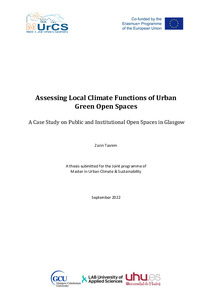Assessing local climate functions of urban green open spaces : a case study on public and institutional open spaces in Glasgow
Tasnim, Zarin (2022)
Tasnim, Zarin
2022
All rights reserved. This publication is copyrighted. You may download, display and print it for Your own personal use. Commercial use is prohibited.
Julkaisun pysyvä osoite on
https://urn.fi/URN:NBN:fi:amk-2022110622090
https://urn.fi/URN:NBN:fi:amk-2022110622090
Tiivistelmä
Urban Green Open Spaces are one of the essential elements that narrate a city's liveability and life-stream. Due to the emergence impact of global climate change and increasing urbanization, 21st century is at a critical state in terms of UGOS adequacy and future consequences. The outdoor environment has fallen into an alarming threat for the habitants during the summer of 2022, with frequent heat wave events exceeding 40°C across Europe and the UK. The concern rises towards the local green spaces' functions if extreme warm days occur more frequently. A mono-functional UGOS with poor performance dominated by a built environment often discourages usability and amenity values. This research paper aims to construct upon improving UGOS - categorized as neighbourhood scale green open space in Glasgow as a case study and explore the opportunities of valued UGOS.
To serve the SDG goal of open space and to meet the climate change adoption goals, it is essential to foresee the potential support with integrated biodiversity and the socio-ecological benefits of UGOS. The gap between policy development and on-ground action weakens these facilities that a local UGOS are meant to provide. Experts’ administrative opinions and the desired expectation from communities get lost in translation due to the high housing demand, economic hub, and business district. A relationship needs to be investigated regarding the landuse of UGOS and its importance to local and broader communities.
The research methodology is reinforced by the thermal comfort simulation analysis, spatial configuration analysis, and interview of experts' opinions. An institutional open space and a typical functioning public open space are assessed as investigation sites. A relevant empirical study and the policies and strategies associated with UGOS in Glasgow give an overview of the current trend of UGOS functions in this paper. Based on the findings and experts’ opinions, attempted thermal comfort indices analysis (MRT, PET, UTCI) and linking them with open space quality indicators combinedly illustrates the broader influences of UGOS as a resilient device for tackling heat stress, bio-diversity loss, health risks etc.
The scientific evidence and high degree of stakeholders’ collaborative insights link the standard variables for future growth and design consideration of UGOS with a climate-focused planning and design approach. Existing scenarios, larger green cover scenarios, ongoing development scenarios, and proposed scenarios from the detailed ENVI-met climatic analysis highlights the key findings and
suitability of UGOS. Based on the analysis result, the concept of this research work can initiate holistic and multidisciplinary planning steps and solutions for future UGOS development.
To serve the SDG goal of open space and to meet the climate change adoption goals, it is essential to foresee the potential support with integrated biodiversity and the socio-ecological benefits of UGOS. The gap between policy development and on-ground action weakens these facilities that a local UGOS are meant to provide. Experts’ administrative opinions and the desired expectation from communities get lost in translation due to the high housing demand, economic hub, and business district. A relationship needs to be investigated regarding the landuse of UGOS and its importance to local and broader communities.
The research methodology is reinforced by the thermal comfort simulation analysis, spatial configuration analysis, and interview of experts' opinions. An institutional open space and a typical functioning public open space are assessed as investigation sites. A relevant empirical study and the policies and strategies associated with UGOS in Glasgow give an overview of the current trend of UGOS functions in this paper. Based on the findings and experts’ opinions, attempted thermal comfort indices analysis (MRT, PET, UTCI) and linking them with open space quality indicators combinedly illustrates the broader influences of UGOS as a resilient device for tackling heat stress, bio-diversity loss, health risks etc.
The scientific evidence and high degree of stakeholders’ collaborative insights link the standard variables for future growth and design consideration of UGOS with a climate-focused planning and design approach. Existing scenarios, larger green cover scenarios, ongoing development scenarios, and proposed scenarios from the detailed ENVI-met climatic analysis highlights the key findings and
suitability of UGOS. Based on the analysis result, the concept of this research work can initiate holistic and multidisciplinary planning steps and solutions for future UGOS development.
